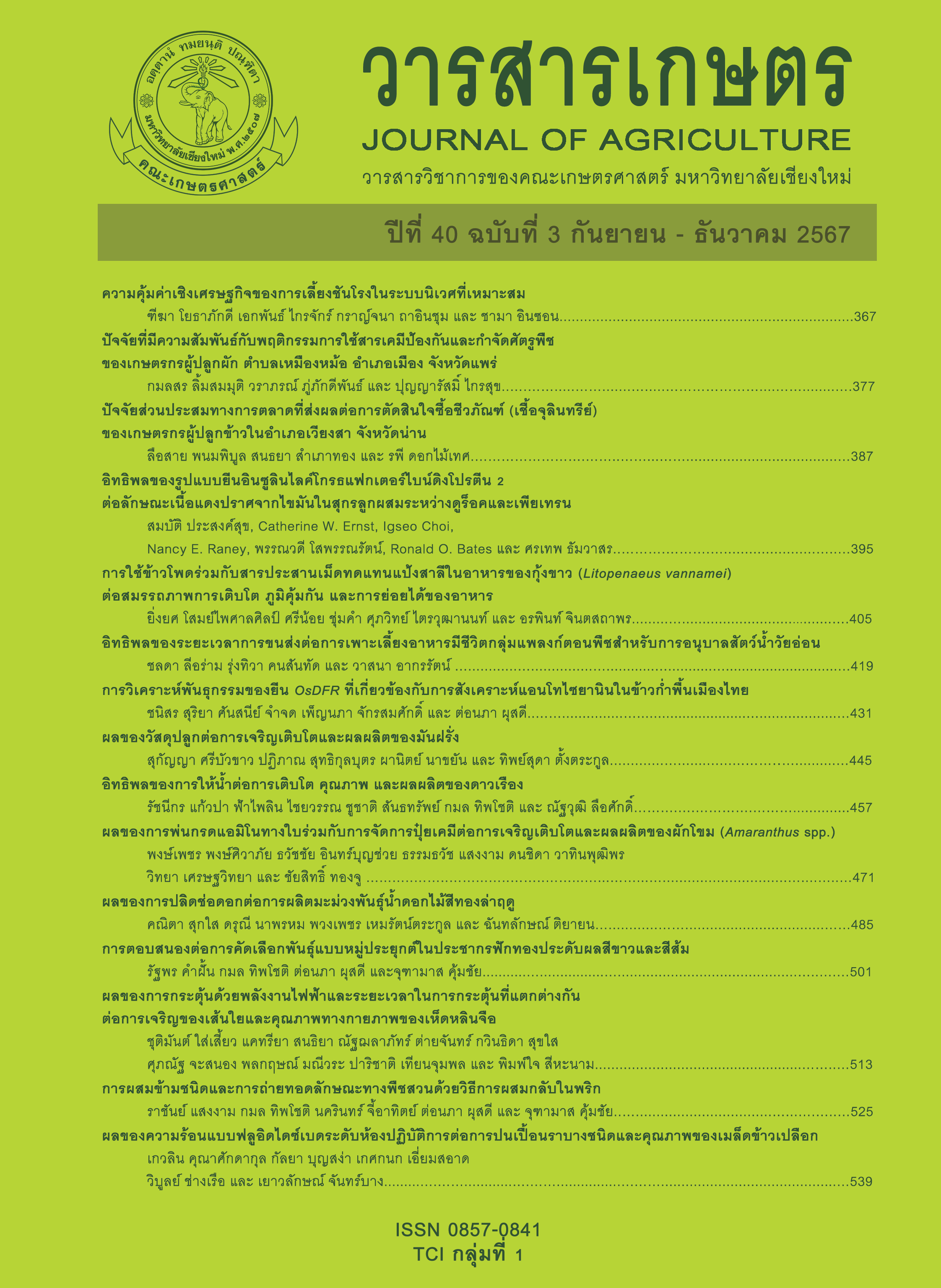การผสมข้ามชนิดและการถ่ายทอดลักษณะด้วย วิธีการผสมกลับในพริก
Main Article Content
บทคัดย่อ
คัดเลือกพันธุ์พริกได้ 10 พันธุ์จากพริกที่ปลูก 44 พันธุ์ และจัดจำแนกชนิดได้ 3 ชนิดได้แก่ Capsicum annuum, Capsicum frutescens และ Capsicum frutescens และ พบว่าความมีชีวิตของละอองเรณูของพริก 10 พันธุ์ มีชีวิตและการงอกของหลอดละอองเรณูสมบูรณ์ ไม่มีความแตกต่างระหว่างพันธุ์ ส่วนการงอกของเมล็ดพันธุ์บุตโจโลเกียมีค่าต่ำสุด 8 % และพันธุ์ซีเอ1449-6-19 เอฟ-3-8 และเอ็ม1116 มีความงอกสูงที่สุด 100% พันธุ์เอ็ม1116 มีการติดผลต่ำที่สุด 16.7 % ส่วนพันธุ์เอฟ-3-8 และพันธุ์บุตโจโลเกีย ติดผลสูงที่สุด 100 % เมื่อผสมข้ามข้ามชนิด ระหว่าง C. frutescens × C. annuum, C. frutescens × C. chinense และ C. annuum × C. chinense พบว่าติดผลทุกคู่ผสม กลุ่มผสมกลับ ติดผล ทุกคู่ผสม พันธุ์ที่ทดสอบทั้งหมดมีความสูงของต้น ความกว้างทรงพุ่ม ความกว้างผล ความยาวของผล และน้ำหนักผลเฉลี่ยแตกต่างอย่างมีนัยสำคัญทางสถิติ ในกลุ่ม F1 พันธุ์ซีเอ1449-6-10-1 × 35-5-3-1 มีความกว้างของผลที่สูงที่สุด ซึ่งกว้างกว่าและแตกต่างอย่างมีนัยสำคัญทางสถิติ กับ ลูกผสมพริกชั่วที่ 1 (F1) อื่น พ่อแม่พันธุ์เกือบทั้งหมดของลูกผสมชั่วที่ 1 (BC1F1 ) และลูกผสมกลับครั้งที่ 2 (BC2F1) ทั้งหมดในกลุ่ม F1 พันธุ์ พีเจ07-1 × บุตโจโลเกีย-1 มีความยาวของผลที่สูงที่สุด ซึ่งยาวกว่าและแตกต่างอย่างมีนัยสำคัญทางสถิติกับ F1 อื่น ๆ พ่อแม่พันธุ์ และ BC1F1 เกือบทั้งหมด และ BC2F1 ทั้งหมด ในกลุ่ม F1 พันธุ์เอ็ม1116-2 × พีเจ07-1 มีน้ำหนักผลเฉลี่ยที่สูงที่สุด ซึ่งสูงกว่าและแตกต่างอย่างมีนัยสำคัญทางสถิติ กับ พันธุ์ BC1F1 และ BC2F1 เกือบทั้งหมด แต่สูงกว่าและต่ำกว่า F1 และพ่อแม่พันธุ์ อย่างมีนัยสำคัญทางสถิติ การผสมระหว่าง C. annuum × C. chinense ไม่เพิ่มน้ำหนักผลต่อต้น และน้ำหนักผลเฉลี่ยของ C. annuum การผสมข้ามชนิด ระหว่าง C. chinense × C. frutescens เพิ่มน้ำหนักผลต่อต้นของพันธุ์จินดา-2 การผสมข้ามชนิด ระหว่าง คู่ผสม 35-5-3-1 × บุตโจโลเกีย-3 และคู่ผสม 35-5-3-2 × บุตโจโลเกีย-1 เพิ่มน้ำหนักผลต่อต้นของพันธุ์35-5-3-1 ถึงแม้การผสมข้ามชนิด ทำให้ขนาดผลเล็กลง เมื่อพริก C. frutescens พันธุ์35-5-3-1 ผสมพันธุ์ กับ C. annuum หลายพันธุ์ ให้ลูกผสมพริกชั่วที่ 1 ที่ให้น้ำหนักผลต่อต้นที่สูงกว่าพ่อและแม่แต่น้ำหนักผลเฉลี่ยน้อยกว่าพ่อและแม่ ลูกผสมพริกชั่วที่ 1 ที่ดีได้แก่ คู่ผสม 35-5-3-1 × เอฟ-3-8-2 คู่ผสม 35-5-3-1 × พีเจ07-2คู่ ผสม 35-5-3-1 × พีเจ05-2 คู่ผสม35-5-3-3 × พีเจ-10-3-2 และคู่ผสม 35-5-3-2 × ซีเอ1449-6-10-2 พริก C. frutescens พันธุ์35-5-3-1 เป็นพันธุ์ทีดีทีสุดในกลุ่มที่ควรใช้ในการผสมพันธุ์กับพริก C. annuum การผสมกลับครั้งที่ 1 ระหว่าง C. annuum × C. chinense ผสมกลับกับ C. annuum พบว่าการผสมกลับเพิ่มน้ำหนักผลต่อต้นของลูกผสมกลับสูงกว่าพ่อแม่ การผสมกลับครั้งที่ 2 ระหว่าง C. annuum × C. frutescens พบว่าการผสมกลับทำให้น้ำหนักผลต่อต้นและน้ำหนักผลเฉลี่ยของลูกผสมกลับ น้อยกว่าพ่อแม่
Article Details

อนุญาตภายใต้เงื่อนไข Creative Commons Attribution-NonCommercial-NoDerivatives 4.0 International License.
เอกสารอ้างอิง
Barchenger, D.W., P. Naresh and S. Kumar. 2019. Genetic resources of Capsicum. pp. 9-23. In: N. Ramchiary and C. Kole (eds.). The Capsicum Genome. WorldVeg Staff Publication. Springer Cham, Switzerland.
Bosland, P.W. 1994. Chiles: History, cultivation, and uses. pp. 347-366. In: G. Charalambous (ed.). Spices, Herbs, and Edible Fungi. Elsevier Science, Amsterdam.
Bosland, P.W. and J.B. Baral. 2007. Bhut Jolokia the world's hottest known chile pepper is a putative naturally occurring interspecific hybrid. HortScience 42(2): 222-224.
Denli, N., A. Ata and H. Taskın. 2022. Expansion of the genetic base by interspecific hybridization in Capsicum annuum and Capsicum chinense. Ekin Journal of Crop Breeding and Genetics 8(1): 33-40.
Hazarika, G., R. Phukan, D. Sarma, R.N. Sarma, S.D. Deka, B. Neog, A. Sarma, S. Gogoi, R.T. Das and H. Ojha, 2023. Genetic relatedness among interspecific hybrids in the genus Capsicum and their implications in breeding King chilli. South African Journal of Botany 163: 744-755.
Heiser, C.B. Jr and B. Pickersgill. 1969. Names for the cultivated Capsicum species (Solanaceae). Taxon 18(3): 277-283.
Inai, S., K. Ishikawa, O. Nunomura and H. Ikehashi. 1993. Genetic analysis of stunted growth by nuclear-cytoplasmic interaction in interspecific hybrids of Capsicum by using RAPD markers. Theoretical and Applied Genetics 87: 416-422.
Jeong, H.S., S. Jan, K. Han, J.K. Kwon and B.C. Kang. 2015. Marker-assisted backcross breeding for development of pepper varieties (Capsicum annuum) containing capsinoids. Molecular Breeding 35(226): 1-10.
Verma, V.K., A. Pandey, A. Thirugnanavel, H. Rymbai, N. Dutta, A. Kumar, T.L. Bhutia, A.K. Jha and V.K. Mishra. 2024. Ecology, genetic diversity, and population structure among commercial varieties and local landraces of Capsicum spp. grown in northeastern states of India. Frontiers in Plant Science 4:15, doi: 10.3389/fpls.2024.1379637.
Kim, Y., G.W. Kim, K. Han, H.Y. Lee, J. Jo, J.K. Kwon, Z. Lemmon, Z. Lippman and B.C. Kang. 2022. Identification of genetic factors controlling the formation of multiple flowers per node in pepper (Capsicum spp.). Frontiers in Plant Science. 13: 884-338.
Kumar, O.A., R.C. Panda and. K.G.R. Rao. 1987. Cytogenetic studies of the F1 hybrids of Capsicum annuum with C. chinense and C. baccatum. Theoretical and Applied Genetics 74(2): 242-246.
Lamichhane S. and S. Thapa. 2022. Advances from conventional to modern plant breeding methodologies. Plant Breeding and Biotechnology 10: 1-14.
Pandit, E., S. Pawar, S.R. Barik, S.P. Mohanty, J. Meher and S.K. Pradhan. 2021. Marker-assisted backcross breeding for improvement of submergence tolerance and grain yield in the popular rice variety ‘Maudamani’. Agronomy 11:7, doi: 10.3390/agronomy11071263.
Pickersgill, B. 1971. Relationships between weedy and cultivated forms in some species of chili peppers (genus Capsicum). Evolution 25: 683-691.
Pickersgill, B. 1992. Barriers to interspecific gene exchange in Capsicum. pp. 57-60. In: Proceedings of 8th Meeting of Genetics and Breeding on Capsicum and eggplant, Rome.
Pickersgill, B. 1997. Genetic resources and breeding of Capsicum spp. Euphytica 96: 129-133.
Shiragaki, K., S. Seko, S. Yokoi and T. Tezuka. 2022. Capsicum annuum with causal allele of hybrid weakness is prevalent in Asia. PLoS ONE 11:7, doi: 10.3390/agronomy11071263.
Shuh, D.M. and J.F. Fontenot. 1990. Gene transfer of multiple flowers and pubescent leaf from Capsicum chinense into Capsicum annuum backgrounds. Journal of the American Society for Horticultural Science 115: 499-502.
Sikora, B. and P. Nowaczyk. 2014. Application of RAPD technique for identification of interspecific hybrids from genus Capsicum. Acta Scientiarum Polonorum Hotorum Cultus 13(1): 155-166.
Subramanya, R. 1983. Transfer of genes for multiple flowers from Capsicum chinense to Capsicum annuum. HortScience 18(5): 747-749.
Tanksley, S.D. and J. Iglesias-Olivas. 1984. Inheritance and transfer of multiple-flower character from Capsicum chinense into Capsicum annuum. Euphytica 33: 769-777.
van Zonneveld, M., M. Ramirez, D.E. Williams, M. Petz, S. Meckelmann, T. Avila, C. Bejarano, L. Ríos, K. Peña, M. Jäger, D. Libreros, K. Amaya and X. Scheldeman. 2015. Screening genetic resources of Capsicum peppers in their primary center of diversity in Bolivia and Peru. PLoS ONE 10:9, doi: org/10.1371/journal.pone.0134663.
Villalon, B., F.J. Dainello, W.N. Lipe and R.M. Taylor. 1986. 'Tam Mild Chile-2' chile pepper. HORTSCIENCE. 21(6): 1468-1469.
Zhu, Z., B. Sun, J. Wei, W. Cai, Z. Huang, C. Chen, B. Cao, G. Chen and J. Lei. 2019. Construction of a high density genetic map of an interspecific cross of Capsicum chinense and Capsicum annuum and QTL analysis of floral traits. Scientific Reports 9:1, doi: 10.1038/s41598-018-38370-0.


